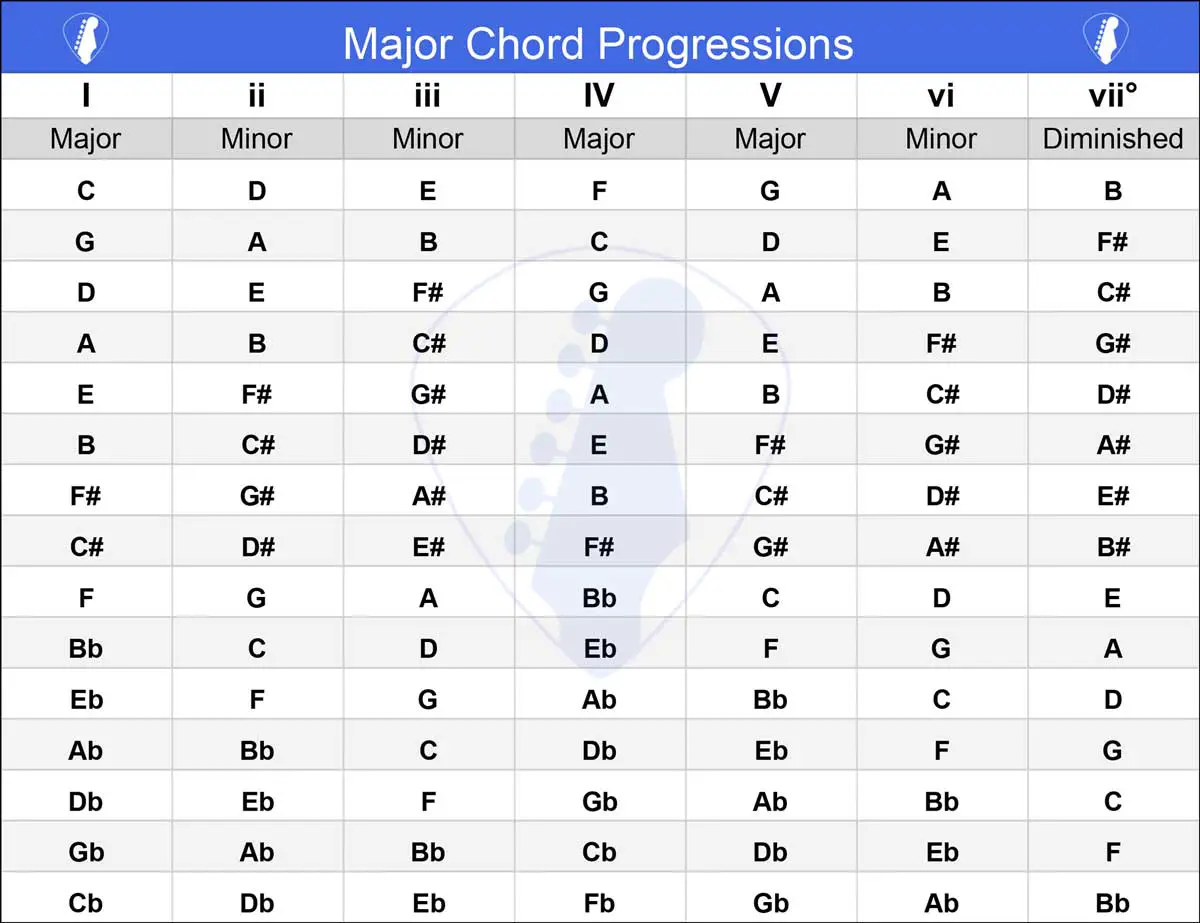Major chord progressions are sequences of chords built on the major scale that create a sense of stability, brightness, and resolution in music. They are a fundamental aspect of harmony and form the foundation of many songs in various genres. Here’s a brief introduction to major chord progressions!

Roman Numerals And Scale Degrees
Reading chord progressions using Roman numerals is a common method in music theory that allows you to analyze and communicate chord relationships within a key. Roman numerals are used to represent the diatonic chords (chords built from the notes of the key’s scale) in a way that is independent of the actual key, making it easier to transpose progressions to different keys.
Here’s how to read and understand Roman numerals for chord progressions:
- Numbering the Scale Degrees: Each note of a scale is assigned a Roman numeral based on its position within the scale. In a major key, the seven scale degrees are numbered as follows:
- I: Tonic (1st scale degree)
- ii: Supertonic (2nd scale degree)
- iii: Mediant (3rd scale degree)
- IV: Subdominant (4th scale degree)
- V: Dominant (5th scale degree)
- vi: Submediant (6th scale degree)
- vii°: Leading Tone (7th scale degree, diminished)
- Major and Minor Chords: Uppercase Roman numerals (I, IV, V) typically represent major chords, and lowercase numerals (ii, iii, vi) represent minor chords. The vii° chord is diminished. In a major key, the diatonic chords are usually:
- I: Major
- ii: Minor
- iii: Minor
- IV: Major
- V: Major
- vi: Minor
- vii°: Diminished
- Using Roman Numerals in Progressions: To represent a chord progression, simply write the appropriate Roman numerals in the order the chords appear. For example, in the key of C major, the I-IV-V progression would be represented as: I-IV-V.
- Indicating Chord Quality: You can use additional symbols to indicate chord quality or alterations:
- Maj: Major chord (e.g., I, IV, V)
- min: Minor chord (e.g., ii, iii, vi)
- °: Diminished chord (e.g., vii°)
- Seventh Chords: You can also indicate seventh chords by adding a 7 after the Roman numeral. For example:
- I7: Major seventh chord
- ii7: Minor seventh chord
- V7: Dominant seventh chord
Major Chord Progressions Chart
A major chord progression chart is a way to visualize all of the chords within any major key. It is a useful reference tool for musicians to use for many purposes including: songwriting, composition, teaching, and gaining new ideas. Musicians often use these charts as a starting point and then add their own unique twists and variations to create something original.

Related: Major and Minor Chord Progressions Chart
Common Major Chord Progressions
Here are 8 standard major chord progressions. Remember that chord progressions are incredibly versatile and can be modified, combined, and extended in various ways – so don’t feel like you have to stay within these guidelines! What is most important is that you like how your song sounds!
ii – V – I
Commonly found in jazz and some pop music, this progression introduces the supertonic (ii) chord alongside the tonic and dominant chords, offering a slightly more sophisticated sound.
I IV I V
This is one of the most common and classic progressions in music. It involves the tonic (I) chord, the subdominant (IV) chord, and the dominant (V) chord, which all lead back to the tonic, creating a strong sense of resolution.
I IV V
This simple yet universal chord progression is the backbone to countless popular songs in every genre. This progression is built upon the degrees of the major scale and involves three primary chords: the tonic (I), the subdominant (IV), and the dominant (V).
I V vi IV
The I-V-vi-IV progression’s predictability can be both comforting and engaging for listeners, and it has a way of creating memorable and catchy melodies. It is sometimes called the Axis progression.
I VI ii V
Commonly found in jazz and other genres, this progression adds a bit more complexity by including a ii chord (minor 2nd degree).
vi IV I V
Another widely used pop progression, this one begins with the relative minor chord (vi) before moving to the major tonic (I).
Circle of Fifths Progression
This progression involves moving around the circle of fifths, which means moving through chords that are a fifth apart
12 Bar Blues
The 12-bar blues progression is one of the most iconic and foundational chord progressions in the blues genre. The progression provides a solid foundation for improvisation, allowing musicians to explore variations in melody, rhythm, and phrasing while staying within the established framework.
Frequently Asked Questions
What Are The 4 Chords In a Major Chord Progression?
In a basic major chord progression, the four primary chords are usually the I, IV, V, and vi. These chords form the foundation of many songs and provide the necessary sense of harmony, tension, and resolution found in good progressions. Most chord progressions will include these chords within them, and changing up the order can completely change the vibe and emotion of a song.
What Is The Saddest Chord Progression?
If you are looking to make sad progressions, you are looking in the wrong place! Look into minor chord progressions for the chords that will make you crie eyry tym.
What Is The 1 5 6 4 Chord Progressions Called?
This progression is sometimes called a 50’s, Heart and Soul, Stand By Me, and Doowop progression, because of its popularity back in those days. It sounds very cliche to me.
Related: Chord Progressions List
What Are Standard Chord Progressions?
Standard chord progressions are progressions that have been used over and over again in popular music. They are universal and very well known.
Related: Circle Of Fifths Chord Progressions
Conclusion
Major chord progressions serve as the backbone of musical harmony as they offer stability, brightness, and emotional resolution. By using roman numerals, musicians can understand chord relationships, allowing for easy analysis and transposition across keys. The major chord progression chart is another tool that aids in songwriting, composition, and teaching, inspiring musicians to infuse their unique creativity into an established structure.
Every chord progression holds its own character and significance. Among the common major chord progressions are the ii-V-I, the I-IV- I – V, the I-V-vi-IV, the i IV ii V, the vi-IV-I-V, the Circle of Fifths, and the 12 Bar blues progressions.
These progressions serve as both a canvas and a guide for musicians looking to add their own unique melodies to timeless harmonies.
Related: How To Read Chord Progressions
